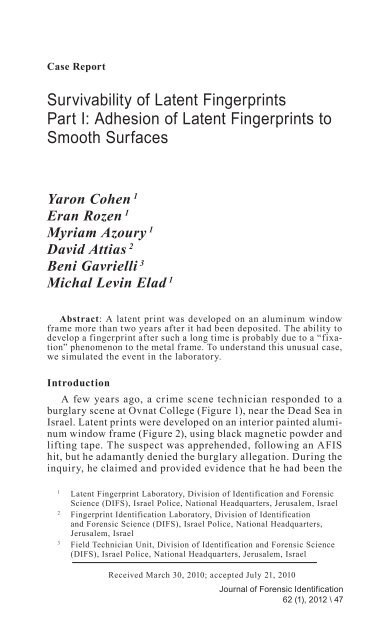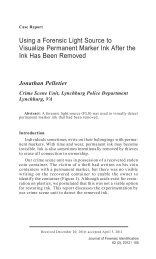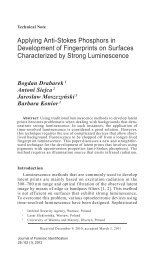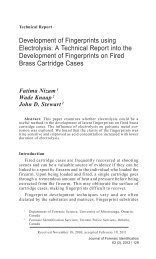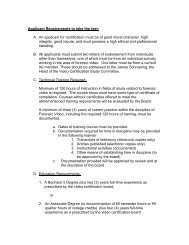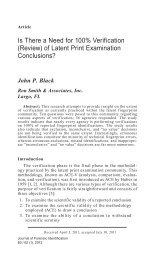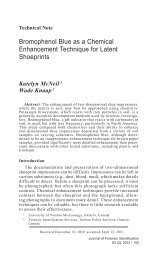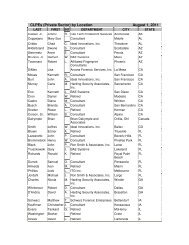Adhesion of Latent Fingerprints to Smooth Surfaces
Adhesion of Latent Fingerprints to Smooth Surfaces
Adhesion of Latent Fingerprints to Smooth Surfaces
You also want an ePaper? Increase the reach of your titles
YUMPU automatically turns print PDFs into web optimized ePapers that Google loves.
Case Report<br />
Survivability <strong>of</strong> <strong>Latent</strong> <strong>Fingerprints</strong><br />
Part I: <strong>Adhesion</strong> <strong>of</strong> <strong>Latent</strong> <strong>Fingerprints</strong> <strong>to</strong><br />
<strong>Smooth</strong> <strong>Surfaces</strong><br />
Yaron Cohen 1<br />
Eran Rozen 1<br />
Myriam Azoury 1<br />
David Attias 2<br />
Beni Gavrielli 3<br />
Michal Levin Elad 1<br />
Abstract: A latent print was developed on an aluminum window<br />
frame more than two years after it had been deposited. The ability <strong>to</strong><br />
develop a fingerprint after such a long time is probably due <strong>to</strong> a “fixation”<br />
phenomenon <strong>to</strong> the metal frame. To understand this unusual case,<br />
we simulated the event in the labora<strong>to</strong>ry.<br />
Introduction<br />
A few years ago, a crime scene technician responded <strong>to</strong> a<br />
burglary scene at Ovnat College (Figure 1), near the Dead Sea in<br />
Israel. <strong>Latent</strong> prints were developed on an interior painted aluminum<br />
window frame (Figure 2), using black magnetic powder and<br />
lifting tape. The suspect was apprehended, following an AFIS<br />
hit, but he adamantly denied the burglary allegation. During the<br />
inquiry, he claimed and provided evidence that he had been the<br />
1<br />
<strong>Latent</strong> Fingerprint Labora<strong>to</strong>ry, Division <strong>of</strong> Identification and Forensic<br />
Science (DIFS), Israel Police, National Headquarters, Jerusalem, Israel<br />
2<br />
Fingerprint Identification Labora<strong>to</strong>ry, Division <strong>of</strong> Identification<br />
and Forensic Science (DIFS), Israel Police, National Headquarters,<br />
Jerusalem, Israel<br />
3<br />
Field Technician Unit, Division <strong>of</strong> Identification and Forensic Science<br />
(DIFS), Israel Police, National Headquarters, Jerusalem, Israel<br />
Received March 30, 2010; accepted July 21, 2010<br />
Journal <strong>of</strong> Forensic Identification<br />
62 (1), 2012 \ 47
owner <strong>of</strong> a window fac<strong>to</strong>ry and had supplied windows <strong>to</strong> the<br />
college more than two and one-half years before the burglary.<br />
The college had been uninhabited since the construction was<br />
completed.<br />
Although the dating or impracticality <strong>of</strong> determining the age<br />
<strong>of</strong> a latent print has been previously discounted [1–8], the possibility<br />
<strong>of</strong> developing high-quality fingerprints with powder in<br />
desert conditions, two and one-half years after the deposition,<br />
may be considered unusual and even “shocking”. We went back<br />
<strong>to</strong> the scene and tried <strong>to</strong> develop fingerprints on the same frame.<br />
An unusual phenomenon was observed: the print residue seemed<br />
<strong>to</strong> have been permanently “fixed”, or at least strongly adhered,<br />
<strong>to</strong> the metal frame. The same result was observed when fresh<br />
prints were deposited by the authors; brush scraping or finger<br />
smearing (i.e., using the brush or the finger on the developed<br />
fingerprint in a robust manner that usually erases the fingerprint)<br />
did not erase the print and it could be developed again and<br />
again (Figures 3, 4). On the basis <strong>of</strong> the suspect’s testimony and<br />
the nature <strong>of</strong> the prints, the suspect was not prosecuted.<br />
In the present work, we tried <strong>to</strong> simulate this effect in the lab.<br />
Potential parameters (e.g., desert climate conditions, surface<br />
type, the window mounting process, the type <strong>of</strong> print residue,<br />
and the fingerprint development technique) were examined.<br />
Figure 1<br />
Ovnat College in the Dead Sea area.<br />
Journal <strong>of</strong> Forensic Identification<br />
48 / 62 (1), 2012
Figure 2<br />
Fingerprint developed by black magnetic powder two years after deposition.<br />
Figure 3<br />
Fingerprint after brush scraping.<br />
Figure 4<br />
Fingerprint after finger smearing.<br />
Journal <strong>of</strong> Forensic Identification<br />
62 (1), 2012 \ 49
Materials and Methods<br />
Sample Preparation<br />
Several nonporous surfaces were used in this study: glass,<br />
Formica, plastic window shutters made <strong>of</strong> polyvinyl chloride<br />
(PVC), an aluminum window frame painted with a powder<br />
coating technique, and anodized aluminum window frames.<br />
Eccrine fingerprints were obtained from donors after they<br />
had washed their hands and worn disposable plastic gloves<br />
for 15 <strong>to</strong> 20 minutes prior <strong>to</strong> depositing the prints. Sebaceous<br />
prints were prepared by wiping the finger across oily regions<br />
(forehead, nose, neck, or hair). Natural fingerprints were taken<br />
from donors without prior treatment.<br />
<strong>Latent</strong> prints were developed using black magnetic powder,<br />
aluminum flake powder, and carbon powder (Lighting Powder<br />
Company, Inc., Jacksonville, FL).<br />
To determine when fingerprints might be deposited during<br />
the processes that windows pass through in the fac<strong>to</strong>ry before<br />
shipment, we looked in<strong>to</strong> two possible deposition routes:<br />
1. Rubbing the aluminum frame with organic solvents,<br />
followed by natural print deposition<br />
2. Rubbing as above followed by cling film wrapping and<br />
print deposition on the wrapping surface<br />
The extreme desert heat was simulated using a dry oven.<br />
A white, powder-coated aluminum frame, Formica, and glass<br />
surfaces were loaded with eccrine and sebaceous prints and were<br />
left for two cycles <strong>of</strong> 9 hours at 70 °C (the measured, summertime<br />
room temperature).<br />
Sebaceous and eccrine prints were deposited on PVC shutters,<br />
painted and anodized aluminum frames, Formica, and glass and<br />
left overnight at room temperature.<br />
The suspect (a window construc<strong>to</strong>r) claimed that during the<br />
construction <strong>of</strong> the windows, he routinely cleaned the aluminum<br />
frames with a <strong>to</strong>luene-based paint thinner prior <strong>to</strong> wrapping<br />
with a blue cling film. In order <strong>to</strong> imitate the working routine<br />
<strong>of</strong> the construc<strong>to</strong>r, we looked first in<strong>to</strong> the deposition process.<br />
We deposited fingerprints after each <strong>of</strong> the steps used by the<br />
window contrac<strong>to</strong>r.<br />
Journal <strong>of</strong> Forensic Identification<br />
50 / 62 (1), 2012
Results<br />
Strong adhesion <strong>of</strong> the prints was observed in the first step<br />
but not in the second. This led <strong>to</strong> the conclusion that the origin<br />
<strong>of</strong> the “fixed” material was not from the cling film but was from<br />
<strong>to</strong>uching the window frame before wrapping with the cling film.<br />
We observed that sebaceous fingerprints were generally<br />
“fixed” only <strong>to</strong> the powder-coated aluminum frame and <strong>to</strong> the<br />
PVC shutters. “Fixation” was not observed with eccrine prints<br />
on any <strong>of</strong> the surfaces that were tested.<br />
The effect <strong>of</strong> the temperature was also studied. Repeating the<br />
experiments at room temperature gave the same fixing results<br />
on these surfaces. This led <strong>to</strong> the conclusion that extreme conditions<br />
were not the reason for print “fixation”.<br />
The same results were obtained using carbon powder, aluminum<br />
f lake, or black magnetic powder for all <strong>of</strong> the surfaces.<br />
Therefore, the study continued using magnetic powder only.<br />
After repeating the experiments using different temperature<br />
conditions, different powders for development, and a variety<br />
<strong>of</strong> surfaces, we found that sebaceous fingerprints were “fixed”<br />
only <strong>to</strong> the PVC shutters and the painted white aluminum frames.<br />
The sebaceous fingerprints were not fixed <strong>to</strong> the other surfaces<br />
and no “fixation” effect was observed with eccrine fingerprints.<br />
Discussion<br />
These experiments led us <strong>to</strong> the conclusion that the interaction<br />
between the sebaceous element <strong>of</strong> the print residue and this<br />
particular surface (PVC shutters and white painted aluminum<br />
frames) result in a “fixation” effect. This effect can occur at<br />
ambient temperatures, with fresh or old prints, but not on all types<br />
<strong>of</strong> surfaces. As far as our experiments show, this phenomenon<br />
does not occur on surfaces such as glass or noncoated aluminum.<br />
Therefore, the coating technology [9] by which powder-coated<br />
window frames and other metal parts are painted could be an<br />
important fac<strong>to</strong>r. The powder-coating process involves painting<br />
metal sufaces using an electrostatic spray <strong>of</strong> polymer-based<br />
dye. After spraying, the surface is heated until the polymer<br />
melts, and the metal achieves its final coated appearance. The<br />
main powder-coating ingredients are resin, curing agent, filler,<br />
pigments, and additives. The type <strong>of</strong> resin and the amount <strong>of</strong> the<br />
other ingredients are selected <strong>to</strong> fit the end product’s desired<br />
properties (water resistance, UV resistance, scratch resistance,<br />
Journal <strong>of</strong> Forensic Identification<br />
62 (1), 2012 \ 51
etc.). The type <strong>of</strong> resin determines the classification <strong>of</strong> powdercoating<br />
mixtures: epoxy, TGIC-polyester, urethane-polyester,<br />
hybrid, and acrylic.<br />
Many exhibits encountered in developing fingerprints are<br />
powder coated. We repeated the experiments <strong>to</strong> test the uniqueness<br />
<strong>of</strong> the window frame case. <strong>Latent</strong> prints were developed<br />
on other powder-coated material such as metallic surfaces on<br />
cars, <strong>to</strong>aster ovens, a <strong>to</strong>aster, a fire extinguisher, a <strong>to</strong>olbox, air<br />
conditioners, and a refrigera<strong>to</strong>r. The latent print fixation effect<br />
was observed again on a refrigera<strong>to</strong>r.<br />
Limited industrial and product information from the various<br />
manufacturers revealed that the aluminum window frame involved<br />
in the present case was coated using white TGIC-polyester<br />
powder paint. Polyesters are more porous than epoxies, and a<br />
high white pigment content (usually TiO 2 ) increases the oils<br />
and hydrophobic agent’s absorption [10]. Moreover, high water<br />
and UV resistance <strong>of</strong> the window frame are acquired by the<br />
addition <strong>of</strong> hydrophobization agents like waxes and silicones <strong>to</strong><br />
the mixture. Based on the basic rule that hydrophobic material<br />
will dissolve in hydrophobic material and hydrophilic in hydrophilic,<br />
it is assumed that the lipid residues <strong>of</strong> the latent print can<br />
be “fixed” on the white powder-coated aluminum frame.<br />
Regarding the PVC shutters, it is assumed that the good<br />
absorption properties <strong>of</strong> PVC might increase the adhesion <strong>of</strong><br />
the fingerprint residues on the surface. PVC may contain plasticizers<br />
up <strong>to</strong> 50% <strong>of</strong> its weight, which leads <strong>to</strong> a high absorption<br />
property in comparison <strong>to</strong> other polymers. PVC is an amorphous<br />
polymer, making it porous and hydrophobic, which readily<br />
absorbs the lipid residues <strong>of</strong> the fingerprints deposits.<br />
Conclusion<br />
These experiments helped us <strong>to</strong> understand why, in the Ovnat<br />
case, it was so easy <strong>to</strong> develop fingerprints deposited two and<br />
one-half years earlier. This case also demonstrates that we must<br />
be cautious in determining the age <strong>of</strong> a fingerprint or the survivability<br />
<strong>of</strong> fingerprints in general.<br />
For further information, please contact:<br />
Michal Levin Elad<br />
National Headquarters<br />
Hainm Bar-Lev Road<br />
Jerusalem 91906<br />
eladmichal@yahoo.ocm<br />
Journal <strong>of</strong> Forensic Identification<br />
52 / 62 (1), 2012
References<br />
1. Midkiff, C. R. Lifetime <strong>of</strong> a <strong>Latent</strong> Print – How Long? Can<br />
You Tell? J. For. Ident. 1993, 43 (4), 386–392.<br />
2. Sharein, R. D. Age <strong>of</strong> <strong>Latent</strong> <strong>Fingerprints</strong> - Food For Thought.<br />
Ident. Canada 1992, 15 (3), 12.<br />
3. Graeme, B. G. Letter <strong>to</strong> the Edi<strong>to</strong>r, re: The Age <strong>of</strong> <strong>Latent</strong><br />
Prints. Ident. Canada Oct. – Dec. 1992, 7.<br />
4. Tuthill, H. Life <strong>of</strong> a <strong>Latent</strong> Impression. Ident. Canada Oct.<br />
1987, 10–11.<br />
5. Clements, W. W. <strong>Latent</strong> <strong>Fingerprints</strong> One Year Later.<br />
Fingerprint Whorld, 1986.<br />
6. Greenlees, D. Age Determination Case Report. Fingerprint<br />
Whorld, April 1994.<br />
7. Moenssens, A. A. Fingerprint Techniques; Chil<strong>to</strong>n, New<br />
York, 1971; pp 26–27.<br />
8. Azoury, M.; Rozen, E.; Uziel, Y.; Peleg-Shironi, Y. Old<br />
<strong>Latent</strong> Prints Developed with Powder: A Rare Phenomenon?<br />
J. For. Ident. 2004, 54 (5), 534–541.<br />
9. King, B.; Zupan, C. Eds. A Guide <strong>to</strong> High-performance<br />
Powder Coating. Powder, Soc. <strong>of</strong> Manufacturing Engineers:<br />
Dearborn, MI, 2002.<br />
10. Williams, N. H. Development <strong>of</strong> <strong>Latent</strong> Prints using Titanium<br />
Dioxide (TiO 2 ) in Small Particle Reagent, White (SPR-W)<br />
on Adhesives. J. For. Ident. 2005, 55 (3), 292–305.<br />
Journal <strong>of</strong> Forensic Identification<br />
62 (1), 2012 \ 53


